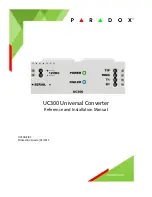
2
3
2. Soldering the headers
3. Plugging the board in
Once you have soldered the headers your
board is ready to be placed into the desired
mikroBUS
™
socket. Make sure to align the cut
in the lower-right part of the board with the
markings on the silkscreen at the mikroBUS
™
socket. If all the pins are aligned
correctly, push the board all the
way into the socket.
Turn the board upward again. Make sure
to align the headers so that they are
perpendicular to the board, then solder the
pins carefully.
Turn the board upside down so that
the bottom side is facing you upwards.
Place shorter pins of the header into the
appropriate soldering pads.
Before using your click board
™
, make sure
to solder 1x8 male headers to both left and
right side of the board. Two 1x8 male headers
are included with the board in the package.
1
ADC3 click carries Microchip’s
MCP3428 16-
bit
multichannel analog-to-digital converter.
The click has four pairs of screw terminals
onboard, letting you access the chip’s four
differential input channels. A pair of onboard
jumpers allow switching between different
I2C addresses. ADC3 click communicates
with the target MCU through mikroBUS I2C
pins (SCL, SDA). It is designed to use either a
3.3V or 5V power supply.
1. Introduction
ADC 3 click Manual v100
0100000087527
click
BOARD
™
www.mikroe.com
ADC 3
click
4. Essential features
ADC3 click can be configured in different
ways depending whether accuracy or speed
is your primary concern. At the highest
resolution of 16-bits, the chip outputs
conversion results at 15 samples per
second. At 14-bits, the sample rate is 60
SPS. Maximum conversion speed is achieved
in 12-bit mode, 240 samples per second.
The I2C interface also has standard, fast and
high speed modes. The chip automatically
calibrates offset and gain errors. A built-in
gain amplifier allows you to convert weak
signals (up to x8 amplification).




















